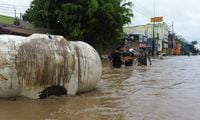Mexico is facing one of its worst flooding disasters in recent memory, with torrential rains sweeping across nearly the entire country, leaving devastation in their wake. Over the past week, at least 41 people have lost their lives as relentless downpours triggered landslides, caused rivers to burst their banks, and led to the collapse of roads and bridges, according to multiple government sources cited by AFP, Reuters, and Digital Journal.
The crisis has affected 31 of Mexico’s 32 states, a staggering breadth that underscores the severity of this year’s rainy season. The central state of Hidalgo has emerged as the epicenter of the disaster, reporting at least 22 deaths, more than 1,000 homes damaged, and 90 communities now cut off from rescuers. The federal security secretariat described the situation as dire, with entire villages isolated and basic infrastructure rendered impassable.
In neighboring Puebla, the toll has also been grim. State officials confirmed at least nine deaths, with around 80,000 people directly affected by the extreme weather. The state government noted that many remain missing, and the number of casualties could still rise as search and rescue operations continue. The impact has been felt most acutely in small rural communities, where landslides and flooding have made access nearly impossible.
Veracruz, on Mexico’s eastern coast, has also seen tragedy, with at least five deaths reported and dramatic scenes playing out in towns like Poza Rica. There, the flooding of the Cazones river submerged much of the town, leaving residents wading through waist- and even neck-deep water. A Navy video, shared widely on social media, showed an officer searching for stranded people as he advanced down a street inundated by the swollen river. In Queretaro, a single fatality was confirmed, but the widespread nature of the flooding has put many more at risk.
President Claudia Sheinbaum has responded by deploying more than 10,000 troops, along with boats, planes, helicopters, and rescue equipment, to assist in relief and recovery efforts. In a post on X, Sheinbaum wrote, “We are deploying members and teams from the Mexican government to open roads and assist communities.” She emphasized the government’s commitment to supporting the population, reopening vital roads, and restoring electrical services in the hardest-hit areas. Emergency shelters have been opened for those displaced from their homes, and distribution of aid is underway, with the military playing a key role in reaching isolated communities.
The Sierra Madre Oriental mountain range, running parallel to the Gulf of Mexico coast, has been identified as the main disaster area. This rugged region is dotted with small, often remote communities, many of which were completely blocked off by landslides and collapsed roads as of Friday, October 10, 2025. An AFP team in Tulancingo, the main access point to the mountains in Hidalgo, reported that all roads leading into the highlands had been closed due to the destruction.
Mexico has experienced particularly heavy rains throughout 2025, with the capital, Mexico City, setting a new rainfall record. Meteorologist Isidro Cano explained to AFP that the intense rainfall since Thursday was the result of a seasonal shift and the formation of clouds as warm, humid air from the Gulf of Mexico rose to meet the mountaintops. Adding to the deluge, a cold front moving down from the north intensified precipitation across much of the country.
Complicating matters further, authorities are closely monitoring the progress of Tropical Depression Raymond and the remnants of Priscilla, which was previously classified as a hurricane. Both systems have been dumping heavy rain on Mexico’s western states, including Chiapas, Guerrero, Oaxaca, and Michoacan, causing additional damage and raising concerns about further flooding. The US National Hurricane Center has warned that Raymond is expected to make landfall in the southern part of Baja California over the weekend, potentially worsening the situation for communities already on edge.
While the government’s response has been swift and multifaceted, the scale of the disaster has stretched resources thin. The Ministry of Defense reported the deployment of over 5,400 personnel to monitor, evacuate, and clean up affected areas, particularly in Veracruz, where power outages and widespread flooding have compounded the hardship. Emergency responders have been seen carrying supplies through flooded streets, sometimes wading knee-deep in water to reach those in need.
The impact of the floods has not been limited to loss of life. Hundreds of schools have been affected, particularly in Hidalgo, disrupting education for thousands of children. The damage to infrastructure—including roads, bridges, and electrical grids—will take months, if not years, to fully repair. The economic toll is still being assessed, but with around 80,000 people affected in Puebla alone, and countless more across other states, the recovery process promises to be long and arduous.
These events in Mexico are part of a broader pattern of extreme weather seen across the globe in 2025. Meteorologists and disaster management officials have pointed to shifting weather patterns and the increased frequency of intense storms as evidence of a changing climate. The convergence of seasonal shifts, tropical storms, and cold fronts has created a perfect storm for flooding, particularly in regions already vulnerable due to geography and infrastructure limitations.
President Sheinbaum’s administration has emphasized the importance of resilience and rapid response, but the crisis has also sparked debate over long-term solutions. Some officials and experts have called for greater investment in flood prevention infrastructure, improved early warning systems, and better land management to reduce the risk of future disasters. Others have highlighted the need to address the underlying drivers of climate change, noting that Mexico’s experience this year is part of a global trend of more frequent and severe weather events.
For now, the focus remains on rescue and relief. With many communities still inaccessible and the threat of further storms looming, the coming days will be critical. As the government continues to mobilize resources and coordinate with local authorities, the resilience of Mexico’s people is once again being tested—this time by the unrelenting force of nature.
The devastation left by the floods in Mexico stands as a stark reminder of the growing challenges posed by extreme weather. As communities begin the long road to recovery, the lessons of this disaster will likely shape the country’s approach to disaster preparedness and climate resilience for years to come.




